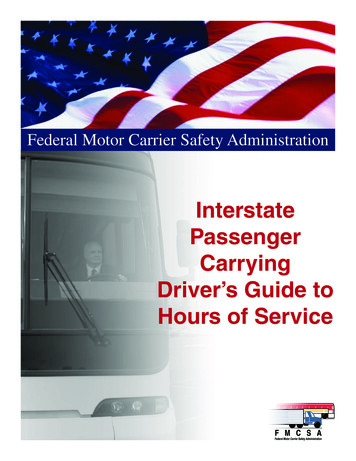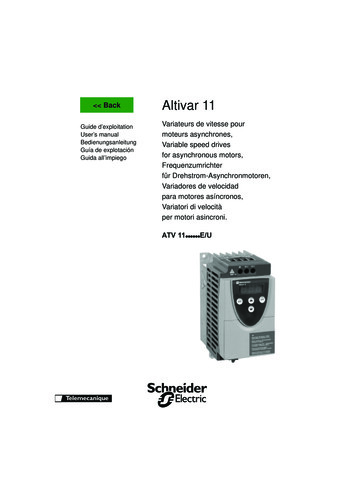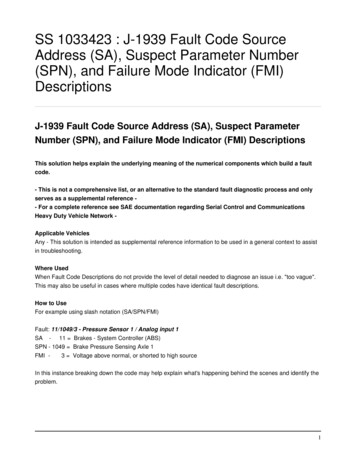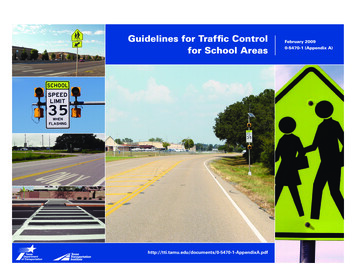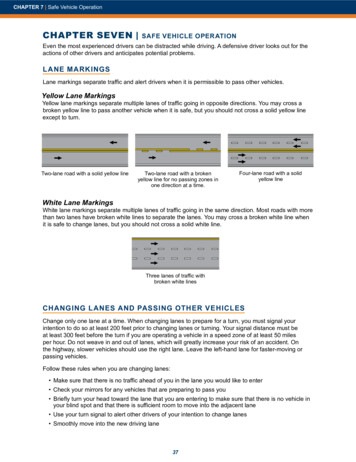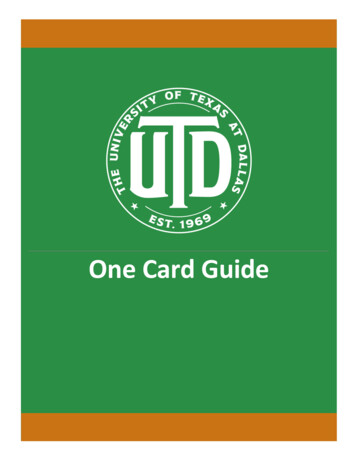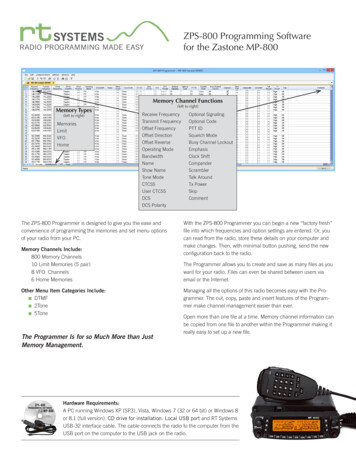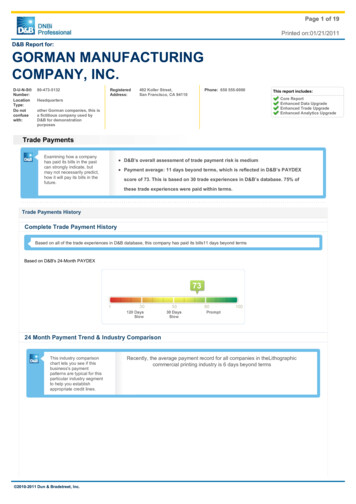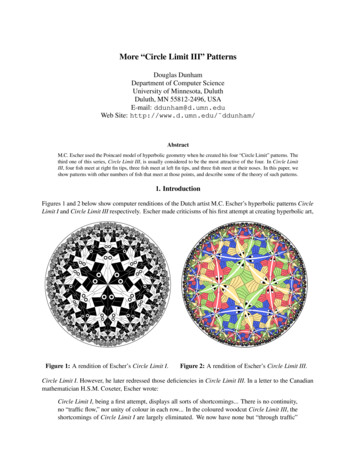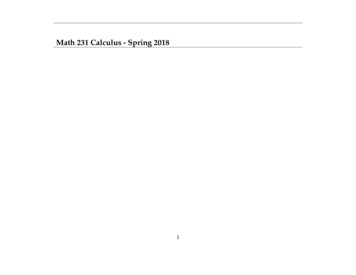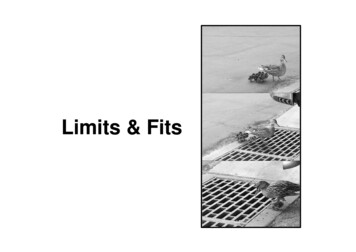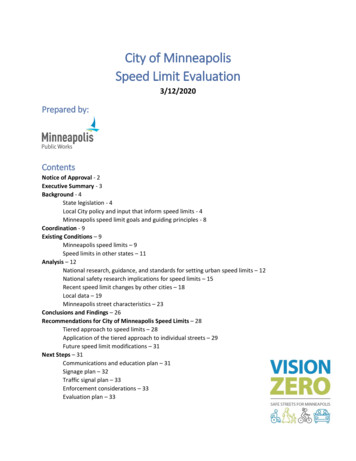
Transcription
City of MinneapolisSpeed Limit Evaluation3/12/2020Prepared by:ContentsNotice of Approval - 2Executive Summary - 3Background - 4State legislation - 4Local City policy and input that inform speed limits - 4Minneapolis speed limit goals and guiding principles - 8Coordination - 9Existing Conditions – 9Minneapolis speed limits – 9Speed limits in other states – 11Analysis – 12National research, guidance, and standards for setting urban speed limits – 12National safety research implications for speed limits – 15Recent speed limit changes by other cities – 18Local data – 19Minneapolis street characteristics – 23Conclusions and Findings – 26Recommendations for City of Minneapolis Speed Limits – 28Tiered approach to speed limits – 28Application of the tiered approach to individual streets – 29Future speed limit modifications – 31Next Steps – 31Communications and education plan – 31Signage plan – 32Traffic signal plan – 33Enforcement considerations – 33Evaluation plan – 33
Executive SummaryThis report is a summary of the analysis undertaken to inform the City of Minneapolis approach tosetting speed limits on City streets in accordance with City policies and recent State legislative authority.The current speed limit on most streets owned by the City of Minneapolis is 30 miles per hour (mph),which is the statutory urban speed limit set by the Minnesota State Legislature. In May 2019, theMinnesota Legislature passed a law granting cities the authority to set speed limits on streets theycontrol, effective August 1, 2019.The report sets the new speed limits as follows: 20 mph on City of Minneapolis minor streets. These are predominately local residential streets. 25 mph on most major City streets. Major streets are generally arterial and collector streets. 35 mph on four short segments of major City streets based on conditions. Alleys and Nicollet Mall will retain speed limits of 10 mph.The map of these new speed limits on City streets is shown on page 30.Speed limits on streets owned by other jurisdictions, including the Minnesota Department ofTransportation, Hennepin County, Minneapolis Park Board, and University of Minnesota, will not bechanged as part of this process.The City of Minneapolis has been partnering with the City of Saint Paul on speed limit changes and willimplement changes on a similar timeline.The new speed limits were determined based on the findings from detailed technical analysis, including: Speed limits lower than 30mph are justified because they:o promote public health, safety and welfare (a person hit at 30 mph is three times as likelyto be killed or severely injured than a person hit at 20 mph),o support City policies,o align with emerging national best practices for safe urban street operations, ando are part of the City’s comprehensive approach to Vision Zero, which includes otherimportant actions to improve safety and support lower, safer speeds. Forthcoming guidance from the National Association of City Transportation Officialsrecommends a tiered approach by categories of streets as a best practice for setting speed limitsand recommends 20 mph speed limit for minor urban streets and a 25 mph speed limit formajor urban streets. These lower speed limits are reasonable given the clear differences in the design, context,safety, expectations, and operations of minor and major City streets. The City would not be able to easily message and educate on a single default speed limit giventhat County and MnDOT streets will continue to have 30 mph speed limits or higher and it’sunknown if or when that will change. Portland and Seattle, which have similarities with Minneapolis in context and street design, havefound success with this tiered approach.3
BackgroundState legislationIn May 2019, the Minnesota Legislature passed and Governor Walz signed into law the authorityallowing cities to set speed limits. Both statutes went into effect August 1, 2019.The City of Minneapolis plans to use the new law to change speed limits from the state statutory urbanspeed limit of 30 mph. Cities must do so “in a consistent and understandable manner based on thecity’s safety, engineering, and traffic analysis.” They also must provide “appropriate signs” and consider“methods to effectively communicate the change to the public.”Full language of this statute is:Minnesota Statutes, Section 169.14, Subd. 5h. Speed limits on city streets. A city may establishspeed limits for city streets under the city's jurisdiction other than the limits provided insubdivision 2 without conducting an engineering and traffic investigation. This subdivision doesnot apply to town roads, county highways, or trunk highways in the city. A city that establishesspeed limits pursuant to this section must implement speed limit changes in a consistent andunderstandable manner. The city must erect appropriate signs to display the speed limit. A citythat uses the authority under this subdivision must develop procedures to set speed limitsbased on the city's safety, engineering, and traffic analysis. At a minimum, the safety,engineering, and traffic analysis must consider national urban speed limit guidance and studies,local traffic crashes, and methods to effectively communicate the change to the public.The other new 2019 speed limit-related statute (Section 169.011, Subd. 64) expands the definition of aresidential roadway and allows cities the authority to enact a speed limit of 25 mph on streets “in anarea zoned exclusively for housing that is not a collector or arterial street.” To utilize this provision, citiesare not required to do a study, but must post speed limit signs at the beginning and end of the roadwaysection. Minneapolis does not currently plan to utilize this statute.Local City policy and input that inform speed limitsExisting City of Minneapolis policy prioritizes traffic safety and access for people walking, biking, andtaking transit. Three different City policies—Minneapolis 2040, the Minneapolis Vision Zero Action Plan,and the Minneapolis Vision Zero policy—specifically reference lowering speed limits to meet thosegoals. Details of existing Minneapolis policy and plans that inform speed limits and a summary of relatedcommunity input are included in the following sections.City Council speed limits staff directionIn December 2019, the City Council adopted a staff direction that accompanied a process-focused speedlimits ordinance change:1. Directing Public Works to present a report on the technical analysis and communications planfor speed limit changes to the Transportation and Public Works Committee by no later thanMarch 17, 2020.2. Directing the City Engineer to set speed limits that:4
support reaching the City’s Vision Zero traffic safety goal of zero traffic deaths or severeinjuries;reflect the City’s Complete Streets policy by improving access and comfort for peoplewalking, biking, and taking transit;reflect projected future street use resulting from anticipated land use changes;support moving people and goods; andare reasonable, comfortable, and technically defensible.Minneapolis Vision Zero policy and Vision Zero Action PlanIn September 2017, the Minneapolis City Council unanimously adopted a Vision Zero resolution, whichset a goal of eliminating traffic deaths and severe injuries on City of Minneapolis streets by 2027. Theresolution explicitly acknowledges that Vision Zero “may result in changes to the City’s approach to theplanning and design of streets” and the potential “to advocate for reduced City speed limits.”The 2020-2022 Vision Zero Action Plan, which was adopted by the City Council in December 2019,identifies “reduce speed limits” as a strategy and includes actions to: “Analyze, determine, and implement new speed limits on City streets. Proactively communicate speed limit changes and the connection between speed and safety. Utilize mobile speed wagons and high-visibility enforcement with warnings to increaseawareness and compliance with new speed limits. Partner with Hennepin County and MnDOT on speed limit changes on their streets asappropriate. Monitor and evaluate results of speed limit changes and communication efforts and adjust asappropriate. Update the City’s Street Design Guide as part of the Transportation Action Plan to support newspeed limits.”The Vision Zero Action Plan also includes “supporting safe speeds” as a critical component of the work:“Given the importance of traffic speeds in supporting safety, supporting safe speeds is a priority in thisplan. Safe speeds can vary for different types of streets based on the context, demands, and design. Nosingle speed-related action alone will lead to safe speeds; a combination of policy changes, streetdesign, education, communications, and enforcement are needed.”Strategic and Racial Equity Action PlanPublic safety is one of eight goals of the 2019 City of Minneapolis Strategic and Racial Equity Action Plan(SREAP). SREAP says “the City prioritizes collaborative and community-inclusive strategies to ensuresafety for all members of our community.” SREAP also has a goal on built environment andtransportation: “the City prioritizes high quality neighborhoods, streets, infrastructure and equitableaccess to multimodal transportation in all parts of the City through thoughtful planning and design.”Minneapolis 2040 Comprehensive PlanThe Minneapolis 2040 Comprehensive Plan, initially adopted by the City Council in 2018, has goals for“healthy, safe, and connected people” and “complete neighborhoods,” which will provide all residents5
“access to employment, retail services, healthy food, parks, and other daily needs via walking, biking,and public transit.”“The Transportation policies of the [Minneapolis 2040] plan support a multimodal network thatprioritizes walking, biking and transit. The polices are intended to achieve outcomes that increase equityin our transportation system, address climate change and reduce carbon emissions, improve humanhealth through improved air quality and increases in active travel, and enable the movement of people,goods, and services across the city.”Minneapolis 2040 actions that inform the City’s approach to speed limits include: Under the Pedestrian policy: “Improve safety for pedestrians, and prioritize pedestrians overother road users, especially at street intersections; focus on signals, crosswalks, lighting,signage, visibility, and lowering vehicular speeds through street design and other measures.” Under the Vision Zero policy: “Pursue changes to state statute to allow reduction of speed limitson Minneapolis streets, and use existing statutory authority to reduce speed limits on streetswith bicycle facilities.” Under the Complete Streets policy: “Implement the Complete Streets Policy throughout allphases of transportation projects and initiatives, including programming, planning, design,construction, operation, and maintenance.”Minneapolis Complete Streets policyThe Minneapolis Complete Streets policy, adopted in May 2016, “establishes a modal priorityframework that prioritizes people as they walk, bicycle, and take transit over people when they drive.”The policy notes that “safety of the most vulnerable street users must be the highest priority, becausethey are the most at risk.”The Complete Streets policy includes a section on street operations: “The operation of the public rightof-way is a significant opportunity to implement the City’s modal priority framework that prioritizespeople as they walk, bicycle, and take transit. The timing of traffic signals will reflect this modal priorityframework, such that signal timing plans will incorporate multimodal metrics. Ongoing monitoring andevaluation of the operation of the public right-of-way should support safe, comfortable, and convenienttravel for people that choose to walk, bicycle, take transit, or drive a vehicle.” Lowering of speeds willsupport the safety and comfort of people as pedestrians, bicyclists, and transit users.Draft Transportation Action PlanThe City of Minneapolis is currently updating its 10-year transportation plan, called the TransportationAction Plan. A draft of the plan was released on March 8, 2020.The Transportation Action Plan has six goals: Climate: Reshape the transportation system to address climate change, using technology,design, and mobility options to aggressively reduce greenhouse gas emissions caused byvehicles. Safety: Reach Vision Zero by prioritizing safety for all people and eliminate traffic fatalities andsevere injuries by 2027.6
Equity: Build and operate a transportation system that contributes to equitable opportunitiesand outcomes for all people.Prosperity: Provide mobility options that move people and goods through reliable connections;retain top talent and grow Minneapolis as the economic engine of the region.Mobility: Embrace and enable innovation and advances in transportation to increase andimprove mobility and access options for all.Active partnerships: Create and seize opportunities to achieve shared goals and responsibilitiesthrough partnering and leveraging funding opportunities with national and regional partnersand others who invest in the city.Minneapolis Public Works is also updating the City’s Street Design Guide in coordination with theTransportation Action Plan. The updated Street Design Guide will use Complete Streets and Vision Zeroas guiding policies and likely will identify target operating speeds between 20 and 25 mph for most Citystreets, depending on context, purpose, and use.City of Minneapolis legislative agenda related to speed limitsWhen adopting the Vision Zero policy in 2017, the City Council also added gaining local control of speedlimits to the City’s legislative agenda: “improve roadway safety, reduce crashes, and supportneighborhood livability by enabling local municipalities to set underlying speed limits, and supportingadditional design features on local roadways.”Community input around traffic speeds and speed limitsPublic Works regularly receives concerns and input about traffic speeds from residents andneighborhood organizations. These concerns and input are received through the City’s 311 system, theover 150 neighborhood meetings attended annually, and through direct communications. Two waysthat Public Works responds to these concerns and input are by deploying mobile speed display signs atapproximately 150 locations annually, and conducting over 300 speed and crash evaluations annually. Intotality, Public Works responds to approximately 8,000 requests annually related to traffic safety. Amajority of these requests relate to local residential streets where most drivers are not exceeding thecurrent 30 mph speed limit. The volume of resident concerns about traffic speeds led to the creation ofthe 2009 traffic calming guidance referenced in Access Minneapolis. Some of the requests fromresidents and neighborhood organizations are to lower speed limits, although the City has lacked theauthority to do so on most streets.During 2019 engagement around the Vision Zero Action Plan, many residents offered concerns aroundtraffic speeds. “Slow down cars and trucks to safer speeds” was consistently ranked as the secondhighest priority area the City should focus on to improve traffic safety. Highlights from 965 responses tothe online Vision Zero Action Plan questionnaire include: 59% of respondents said “speed limits that are too high” was somewhat a problem or asignificant problem; 73% said “streets that are wide and encourage higher driving speeds” was somewhat a problemor a significant problem; and 90% said they are somewhat or very concerned about speeding traffic.7
During the comment period on the draft 2020-2022 Vision Zero Action Plan, the City received 139comments specifically about the strategy to lower speed limits. There was more support expressed thanopposition to reducing speed limits. Supporters generally spoke to the safety benefits of lower speedswhile opponents often expressed skepticism about the value of reducing the speed limit and suggestedenforcing the existing speed limits instead. The plan was adjusted to include a section on the interconnected strategies needed to support safe speeds and an enforcement-related action was added withthe speed limit strategy.Minneapolis speed limit goals and guiding principlesBased on City Council actions, City policies and plans, the following set of goals and guiding principleswere established regarding speed limits.Speed limit goalsThe City manages its “public right-of-way to protect the public health, safety and welfare” (MinneapolisCode of Ordinances, chapter 451.20, Subd. 5). Therefore, the City seeks to achieve these goals with theproposed speed limits process: Set speed limits that:o support reaching the City’s Vision Zero traffic safety goal of zero traffic deaths or severeinjuries;o reflect the City’s Complete Streets policy by improving access and comfort for peoplewalking, biking, and taking transit;o reflect projected future street use resulting from anticipated land use changes;o support moving people and goods; ando are reasonable, comfortable, and technically defensible. Educate street users so that they know about new speed limits and the important connectionbetween speed and safety.Speed limit guiding principles Set speed limits in a consistent and understandable manner. Create and follow a technical and data-driven review process that is defensible and replicable byother cities in Minnesota. Partner where feasible with neighboring cities, Hennepin County, and MnDOT to maximizeconsistency in new speed limits. Coordinate the speed limit change with Vision Zero Action Plan implementation. Monitor and evaluate the results of the speed limit changes, and adjust if necessary.8
CoordinationMinneapolis Public Works has collaborated with internal and external partners throughout the speedlimit analysis. Minneapolis has partnered with the City of Saint Paul to ensure consistency in generalapproach, communications, and implementation timeline. Key decisions around process, analysis,recommendations, and implementation were made jointly between the two cities.Internal collaborators include the City Attorney’s office, Communications, Police, and the Vision ZeroTask Force. Minneapolis Public Works also coordinated with the Minnesota Department ofTransportation, Hennepin County, Minneapolis Park and Recreation Board, and Metro Transit. Cityengineers in adjacent cities were informed of process, timeline, goals, and approach. Staff shared goals,background information, and process steps with the City Engineers Association of Minnesota and Leagueof Minnesota Cities.A draft version of this analysis was shared with four engineers from different perspectives for a peerreview. Each reviewer felt that the recommendations were technically defensible based on thebackground and analysis while their questions and feedback helped us further strengthen our approach.Existing conditionsMinneapolis speed limitsThe current speed limit on most streets owned by the City of Minneapolis is 30 mph (Figure 1), which isthe statutory urban speed limit set by the Minnesota State Legislature. The speed limit on mostHennepin County roads and MnDOT trunk highways is also 30 mph, although a few more segments havehigher speed limits. The speed limit on Minneapolis Park and Recreation Board parkways is 25 mph.9
Figure 1: Speed limits on streets in Minneapolis as of January 202010
Speed limits in other statesIn 2017, a majority of states (30) had a default urban speed limit of 25 mph, including all of Minnesota’sneighboring states (see Figure 2). In addition, 17 states allow 20 mph speed limit if certain conditions aremet. Since 2017 some states have made changes to their speed limits under various conditions.Figure 2: Default urban speed limit11
AnalysisNational research, guidance, and standards for setting urban speed limitsIn recent years, the transportation industry has sought change in approach to setting urban speed limitsand that is now beginning to yield new and updated guidance. New and updated guidance is movingtoward a safe-systems approach to setting speed limits on urban streets rather than one focused oncurrent observed traffic speeds. This section outlines this new and updated guidance.National Transportation Safety BoardIn 2017, the National Transportation Safety Board released a comprehensive report Reducing SpeedingRelated Crashes Involving Passenger Vehicles. The report directly addresses the traditional methods forsetting speed limits and the challenges with those methods:“Typically, speed limits are set by statute, but adjustments to statutory speed limits aregenerally based on the observed operating speeds for each road segment—specifically, the 85thpercentile speed of free-flowing traffic. Raising speed limits to match the 85th percentile speedcan result in unintended consequences. It may lead to higher operating speeds, and thus ahigher 85th percentile speed. In general, there is not strong evidence that the 85th percentilespeed within a given traffic flow equates to the speed with the lowest crash involvement ratefor all road types. Alternative approaches and expert systems for setting speed limits areavailable, which incorporate factors such as crash history and the presence of vulnerable roadusers such as pedestrians” (Executive Summary, Page x).The report goes on to say:“The relationship between speed and injury severity affects more than just speeding vehicleoccupants. This is particularly true in urban areas where the interaction between vehicles andvulnerable road users such as pedestrians is considerably higher. A safe system approach tosetting speed limits emphasizes the consideration of human biomechanical tolerances and shiftsthe focus from vehicles to all road users. Especially in urban areas, it has emerged as analternative to the use of the 85th percentile speed in setting speed limits in speed zones”(Rethinking How to Set Speed Limits, page 29).The report recommends changes to the Federal Highway Administration’s Manual on Uniform TrafficControl Devices (“MUTCD”) “to, at a minimum, incorporate the safe system approach for urban roadsto strengthen protection for vulnerable road users” (page 29).Manual on Uniform Traffic Control Devices (MUTCD)The MUTCD sets minimum standards and provides guidance to ensure uniformity and consistency onthe public transportation system. In the State of Minnesota, the Minnesota Manual on Uniform TrafficControl Devices (MN MUTCD) is used. The MN MUTCD and MUTCD are, in general, identical in language,and exact in language as it references speed limits. It is routine that new and addendum language of theMUTCD is adopted by the MN MUTCD.Based on the National Transportation Safety Board recommendation, the National Committee onUniform Traffic Control Devices (NCUTCD) began collecting feedback and considering changes to theMUTCD related to setting speed limits.12
The current MUTCD offers the following standards (not guidance) for setting speed limits: “Speed zones (other than statutory speed limits) shall only be established on the basis of anengineering study that has been performed in accordance with traffic engineering practices. Theengineering study shall include an analysis of the current speed distribution of free-flowingvehicles.” “The Speed Limit sign shall display the limit established by law, ordinance, regulation, or asadopted by the authorized agency based on the engineering study. The speed limits displayedshall be in multiples of 5 mph” (Section 2B.13 page 56).The current MUTCD offers the following guidance (not standard) on setting speed limits: “States and local agencies should conduct engineering studies to reevaluate non-statutoryspeed limits on segments of their roadways that have undergone significant changes since thelast review, such as the addition or elimination of parking or driveways, changes in the numberof travel lanes, changes in the configuration of bicycle lanes, changes in traffic control signalcoordination, or significant changes in traffic volumes.” “When a speed limit within a speed zone is posted, it should be within 5 mph of the 85thpercentile speed of free-flowing traffic” (Section 2B.13, page 58).The current MUTCD offers the following option (not guidance or standard) on setting speed limits: “Other factors that may be considered when establishing or reevaluating speed limits are thefollowing:A. Road characteristics, shoulder condition, grade, alignment, and sight distance;B. The pace;C. Roadside development and environment;D. Parking practices and pedestrian activity; andE. Reported crash experience for at least a 12-month period” (Section 2B.13, page 58).The National Committee on Uniform Traffic Control Devices (NCUTCD) recently approved recommendedchanges to the current MUTCD related to setting speed limits. These recommendations are provided toFHWA for consideration in the next edition of the MUTCD, which requires federal rulemaking. TheFHWA has not initiated rule making for the next edition of the MUTCD yet, but this is expected to beginwithin the next year. The recommendations approved by the NCUTCD include: Removing from standard that “The engineering study shall include an analysis of the currentspeed distribution of free-flowing vehicles.” Upgrading and revising the considerations for establishing speed zones to read:“Factors that should be considered when establishing or reevaluating speed limitswithin speed zones are the following:A. Speed distribution of free-flowing vehicles (such as current 85th percentile, the pace,and review of past speed studies).B. Reported crash experience for at least a 12-month period relative to similarroadways.C. Road characteristics (such as lane widths, curb/shoulder condition, grade,alignment, median type, and sight distance).D. Road context (such as roadside development and environment including number ofdriveways and land use, functional classification, parking practices, presence ofsidewalks/bicycle facilities).13
E. Road users (such as pedestrian activity, bicycle activity).”Revising the guidance statement regarding the posted speed limit being made within 5 mph ofthe 85th percentile speed to apply only “on freeways, expressways, or rural highways.”National Association of City Transportation Officials speed limit guidanceThe National Association of City Transportation Officials (NACTO) guide City Limits: Setting Safe Speedsfor Urban Streets provides urban speed limit guidance and will be released in March 2020.NACTO’s guide identifies two general approaches (citywide or category of street) for setting speed limitsand states the following:“Cities have two options for setting default speed limits: citywide or by category of street (e.g.,major, minor, alley).Citywide speed limits are generally easier to implement and may be easier for drivers to follow.However, in cities where there is clear differentiation between major arterial streets and local orminor streets, setting speed limits based on category of street can sometimes allow cities tolower speed limits on a large number of streets below what would be allowable citywide (i.e., 20mph on minor streets vs. 25 mph citywide).If cities have the authority to set default speed limits, they should decide whether to implementcitywide limits or category limits based on what makes the most sense given the localconditions” (page 46).If setting a default citywide speed limit, NACTO recommends using 25 mph. “Setting or lowering defaultcitywide speed limits is an inexpensive, scalable way to quickly improve safety outcomes, and establish abasis for larger safety gains. Default citywide limits also provide consistent expectations and messagesabout speed across the jurisdiction, which is easy for drivers to follow” (page 47).If using category speed limit approach, NACTO recommends: Major streets: 25 mph.“A 25 mph speed limit on urban multi-lane streets has demonstrable safety benefits for allusers. Major streets feature a combination of high motor vehicle traffic volume, signalization ofmajor intersections, and an inherently multimodal street environment” (page 49). Minor streets: 20 mph.“A 20 mph speed limit on minor streets supports safe movement and contextually appropriatedesign on the majority of city streets. Since minor streets tend to have either very low volumesor operate at the speed of the most cautious driver, cities can apply a category speed limit tominor streets without detailed review of street characteristics. Minor streets include physicallysmall streets where low speeds are often already present, as well as low-vehicle-volume streetswith few or no transit stops” (page 50). Alleys and shared streets: 10 mph14
NACTO identifies that cities can define “slow zones.”“Slow Zones are specifically designated areas with slower speeds than otherwise similar streetsin the same jurisdiction. Neighborhood-scale or site-specific zones are useful for addressinghigh-priority areas such as areas with elevated collision rates or sensitive land uses (schools,parks, etc.). Cities should create slow zones based on their own location-specific needs, butseveral types of slow zones are relatively common” (page 54).The guide provides examples of potential slow zones in school, park, and senior areas; neighborhoodsand districts; and in downtown areas.The NACTO guide includes additional details for analyzing speeds on major streets if a jurisdiction is notable to set default citywide or category speed limits. The guide recommends setting safe speed limits byevaluating conflict density and activity level. Their recommendations say that streets with high activityand high conflict density should have 20 mph speed limits while urban streets with low activity levelsand low conflict density should have maximum speed limits of 35 m
speed limits." The Vision Zero Action Plan also includes "supporting safe speeds" as a critical component of the work: "Given the importance of traffic speeds in supporting safety, supporting safe speeds is a priority in this plan. Safe speeds can vary for different types of streets based on the context, demands, and design.
